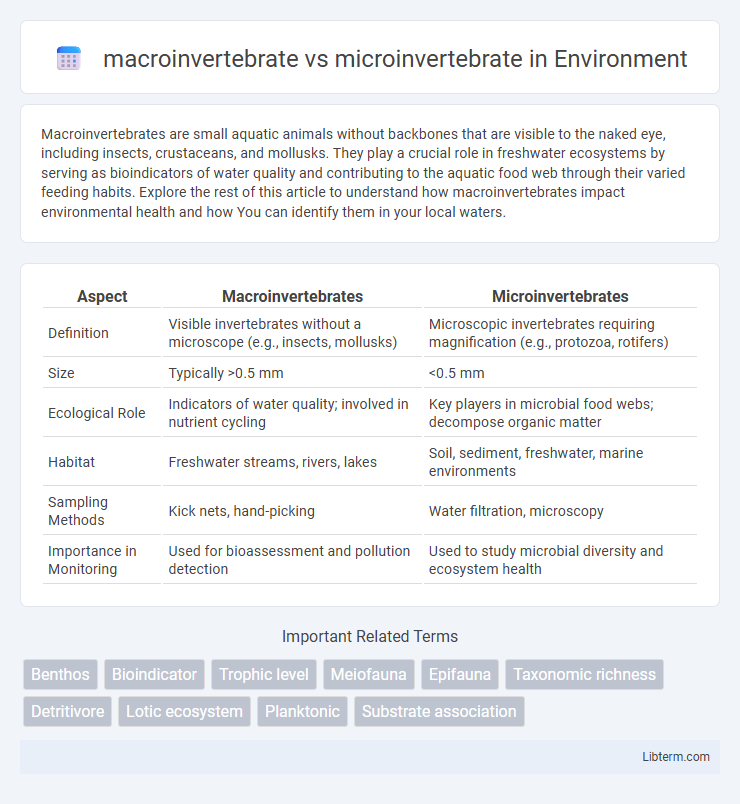Macroinvertebrates are small aquatic animals without backbones that are visible to the naked eye, including insects, crustaceans, and mollusks. They play a crucial role in freshwater ecosystems by serving as bioindicators of water quality and contributing to the aquatic food web through their varied feeding habits. Explore the rest of this article to understand how macroinvertebrates impact environmental health and how You can identify them in your local waters.
Table of Comparison
| Aspect | Macroinvertebrates | Microinvertebrates |
|---|---|---|
| Definition | Visible invertebrates without a microscope (e.g., insects, mollusks) | Microscopic invertebrates requiring magnification (e.g., protozoa, rotifers) |
| Size | Typically >0.5 mm | <0.5 mm |
| Ecological Role | Indicators of water quality; involved in nutrient cycling | Key players in microbial food webs; decompose organic matter |
| Habitat | Freshwater streams, rivers, lakes | Soil, sediment, freshwater, marine environments |
| Sampling Methods | Kick nets, hand-picking | Water filtration, microscopy |
| Importance in Monitoring | Used for bioassessment and pollution detection | Used to study microbial diversity and ecosystem health |
Introduction to Invertebrate Classification
Macroinvertebrates and microinvertebrates differ primarily in size, with macroinvertebrates typically visible to the naked eye and microinvertebrates requiring magnification for observation. Invertebrate classification categorizes these organisms based on characteristics such as body structure, exoskeleton presence, and habitat, spanning diverse phyla like Arthropoda, Mollusca, and Annelida. Understanding the distinction between macro- and microinvertebrates aids ecological studies by highlighting varying roles in aquatic and terrestrial ecosystems, including bioindicator species used for water quality assessment.
Defining Macroinvertebrates
Macroinvertebrates are aquatic animals without a backbone that are visible to the naked eye, typically larger than 0.5 millimeters, and include species such as insects, crustaceans, and mollusks. They serve as vital bioindicators in freshwater ecosystems, reflecting water quality and habitat conditions due to their varying sensitivity to pollution. In contrast, microinvertebrates are smaller, often microscopic, and encompass protozoa and tiny crustaceans, playing different ecological roles in nutrient cycling and food webs.
Understanding Microinvertebrates
Microinvertebrates are microscopic animals essential for aquatic ecosystem health, playing crucial roles in nutrient cycling and energy flow. Unlike larger macroinvertebrates, microinvertebrates include protozoa, nematodes, and rotifers, which influence sediment stability and water quality. Studying microinvertebrate diversity and abundance provides sensitive bioindicators for monitoring pollution and environmental changes in freshwater habitats.
Key Differences: Macroinvertebrates vs Microinvertebrates
Macroinvertebrates are aquatic animals visible to the naked eye, typically larger than 0.5 millimeters, such as insects, crustaceans, and mollusks, playing a vital role in freshwater ecosystems and water quality assessment. Microinvertebrates, usually smaller than 0.5 millimeters, include microscopic organisms like rotifers, nematodes, and protozoans, crucial for nutrient cycling and as a food source for larger aquatic life. The key differences lie in size, visibility, and ecological roles, with macroinvertebrates commonly used as bioindicators due to their sensitivity to environmental changes, whereas microinvertebrates contribute significantly to microbial food webs and sediment processes.
Habitat Preferences and Distribution
Macroinvertebrates typically inhabit freshwater ecosystems such as streams, rivers, and lakes, favoring substrates like rocks, sediment, and aquatic vegetation for shelter and feeding. Microinvertebrates, including protozoa and small crustaceans, thrive in a wider range of habitats, from soil and freshwater to marine environments, often occupying microscopic niches within biofilms and sediment pores. Distribution of macroinvertebrates is often influenced by water quality and flow conditions, whereas microinvertebrate populations are shaped by factors including nutrient availability, pH, and organic matter content.
Ecological Roles and Importance
Macroinvertebrates, such as insects and crustaceans, play critical roles in aquatic ecosystems by contributing to nutrient cycling, organic matter decomposition, and serving as key indicators of water quality. Microinvertebrates, including protozoans and microscopic worms, are essential for maintaining microbial food webs and facilitating the breakdown of organic material at a micro scale. Together, these organisms support biodiversity, enhance ecosystem stability, and provide foundational resources for higher trophic levels.
Methods for Sampling and Identification
Macroinvertebrate sampling typically involves using kick nets or Surber samplers to collect organisms from streambeds, followed by sorting in the lab using stereomicroscopes and identification keys based on morphological characteristics. Microinvertebrate sampling requires water filtration or centrifugation methods to concentrate organisms, with identification relying on compound microscopy and often molecular techniques such as DNA barcoding for accurate taxonomic resolution. Both methods emphasize preserving specimens in ethanol for subsequent analysis and use standardized protocols to ensure data comparability in ecological assessments.
Indicator Value in Environmental Monitoring
Macroinvertebrates, such as aquatic insects and mollusks, serve as robust bioindicators in environmental monitoring due to their sensitivity to changes in water quality and habitat conditions. Microinvertebrates, including protozoa and small crustaceans, provide complementary insights by responding quickly to pollutant fluctuations and nutrient levels at a microbial scale. The combined analysis of macroinvertebrate and microinvertebrate communities enhances the accuracy of ecological assessments, enabling precise detection of pollution sources and ecosystem health status.
Challenges in Conservation and Study
Macroinvertebrates and microinvertebrates present distinct challenges in conservation and study due to their size differences, with macroinvertebrates being easier to sample and identify through standard biomonitoring techniques while microinvertebrates require advanced microscopy and molecular tools for accurate assessment. Conservation efforts for macroinvertebrates often focus on habitat protection and water quality, whereas microinvertebrate conservation is complicated by the lack of comprehensive ecological data and their sensitivity to subtle environmental changes. Limited taxonomic knowledge and difficulties in detecting microinvertebrate diversity hinder effective management and scientific understanding of their ecological roles compared to the more studied macroinvertebrates.
Future Research Directions
Future research on macroinvertebrates and microinvertebrates should prioritize the development of advanced molecular techniques to improve species identification and ecological status assessments. Integrating high-throughput DNA sequencing with traditional morphological methods can enhance biodiversity monitoring and inform conservation strategies. Investigating the functional roles and community dynamics of these groups under changing environmental conditions will provide insights into ecosystem resilience and health.
macroinvertebrate Infographic

 libterm.com
libterm.com